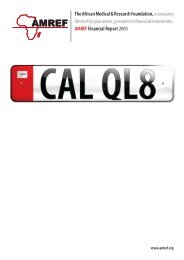Celebrating African Motherhood - Amref
Celebrating African Motherhood - Amref
Celebrating African Motherhood - Amref
You also want an ePaper? Increase the reach of your titles
YUMPU automatically turns print PDFs into web optimized ePapers that Google loves.
44<br />
A Blend of Health and Culture<br />
A thick ceiling of branches provides a shaded enclosure for morans taking<br />
part in the Olpul session in a grove of trees on a forested mountainside in<br />
Entasoopia, Magadi Division. ‘Stop FGM!’ screams a poster pinned to the<br />
trunk of a tree. In the privacy and familiar surroundings of a bush a little<br />
way off , a nurse from the Olkirimatian health centre counsels and tests<br />
morans who want to know their HIV status.<br />
“Our cultural practices used to put us in danger of getting HIV, but we<br />
did not realise it,” says Lelein Kanunga, chief of the morans of Magadi<br />
Division. Morans are young, circumcised Maasai men aged between 14-25<br />
years. They are the warriors of the community, charged with duties such<br />
as searching for stolen livestock and defending the community against<br />
attack. Renowned for their proud cultural heritage and traditional way of<br />
life, the Maasai are a very conservative people. As chief, 18-year-old Lelein,<br />
is the spokesperson for his age group, consulting elders on their behalf and<br />
communicating key decisions to his peers. He has been trained by AMREF<br />
as a peer educator for youth on reproductive health issues, including HIV.<br />
Morans would share one razor to shave their heads. Morans are also very<br />
popular with girls; in fact, they are encouraged to have many girlfriends,<br />
but this again makes them vulnerable to HIV. They would get sick but did<br />
not know why. Then AMREF trained a group of moran chiefs about HIV and<br />
other health issues so that they could go and teach their fellow morans.<br />
They realised that there were a lot of things that needed to change in their<br />
community to stop their people from dying. The moran chiefs are ‘mobile<br />
peer educators’ and are able to move with the morans when they migrate<br />
to search for pasture and water for their livestock. And so the morans<br />
can always access reproductive health information and services such as<br />
condoms and referral for STI treatment.<br />
“The girl morans are known as esiankikin. They have unique problems<br />
which we are now addressing. Our girls are circumcised, and yet there<br />
is really no good reason for doing it; it’s based on the belief that it will<br />
prevent women from straying from their marital homes. As soon as they<br />
are circumcised, the young girls are married off , often to much older men. .<br />
The girls get pregnant when they are very young and their bodies es are not<br />
strong enough to have babies. Many men beat their wives and all this is





